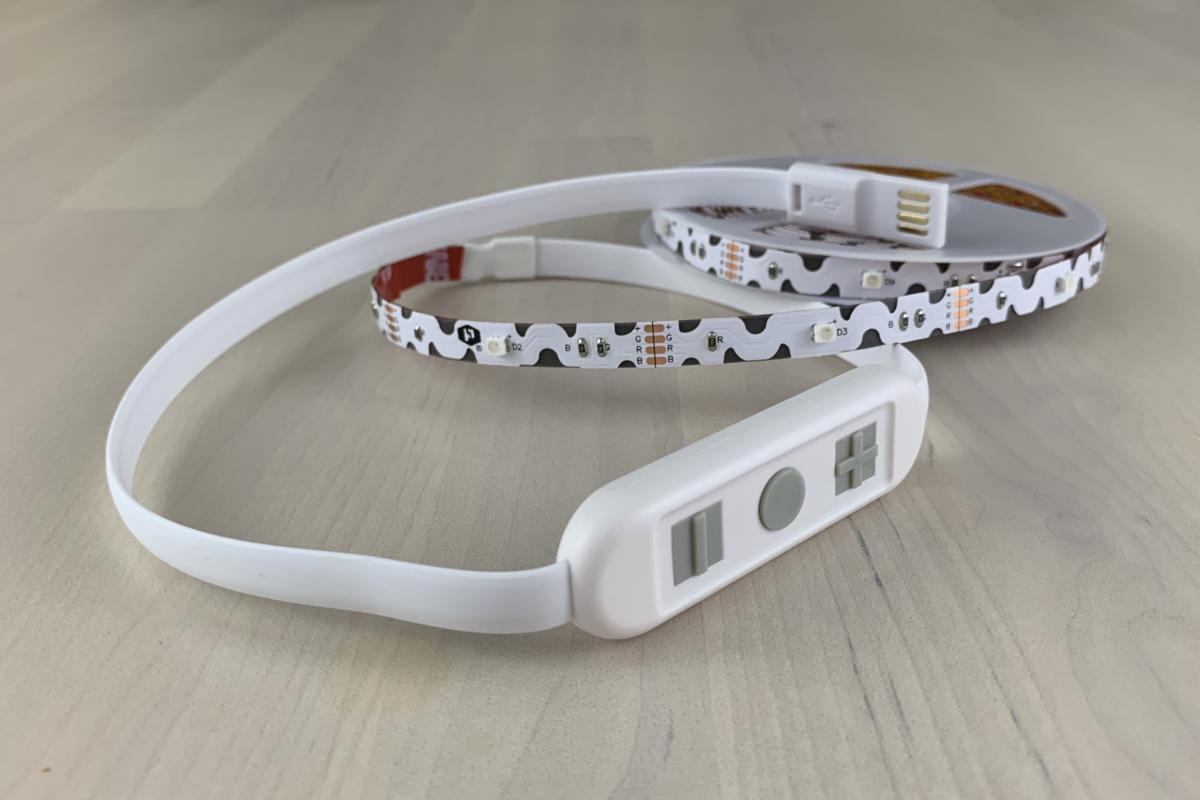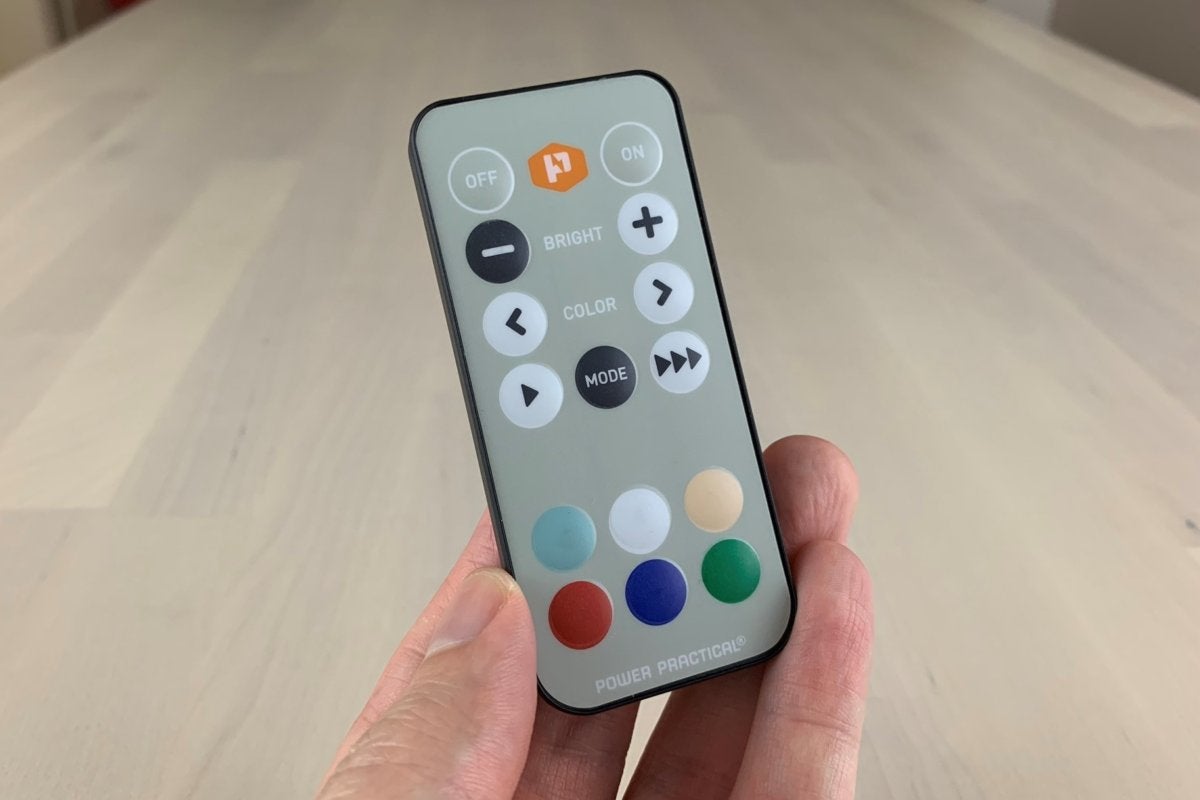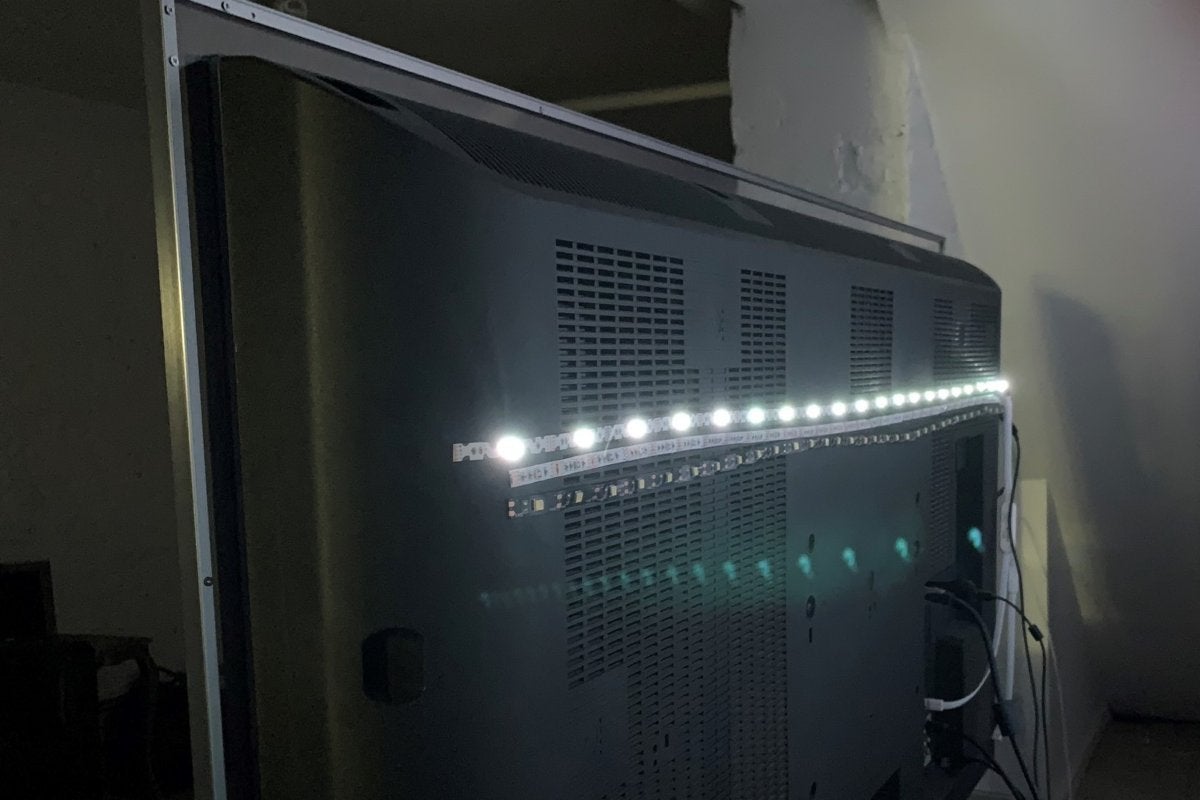Expert's Rating
Pros
- Easy to install
- 15 color modes
- Three lighting modes
Cons
- No “true” white (i.e., 6500K) mode
- Fewer brightness steps than we’d like
Our Verdict
While this version of the Luminoodle brings 15 colors and three lighting modes to the table, it lacks a true white mode, and it has fewer brightness steps than we’d like.
Best Prices Today: Power Practical Luminoodle Color Bias Lighting
If you’re looking for a moderately priced, multi-color bias lighting strip for the back of your TV, the Luminoodle Color Bias Lighting makes for a solid choice. Boasting a range of 15 colors, three fade modes, and an RF remote, the Luminoodle is easy to install and helps to boost the apparent contrast on your TV screen. Like other color light strips we’ve tried, however, this particular Luminoodle lacks a “true” (i.e., 6500K) white mode that helps to prevent color distortion in the picture, while a few more brightness steps would’ve allowed for more careful calibration.
Installation and setup
Like many other bias lighting strips, the Luminoodle arrives wrapped around a plastic reel. Just unspool the strip, peel off the protective backing, and then stick the strip onto the back of your TV, ensuring first that the back of your set is clean and free of dust. You can snip off any extra length with a pair of scissors, so long as you’re careful to snip along one of the safe areas marked by a thin black line.
 Ben Patterson/IDG
Ben Patterson/IDG
The Luminoodle Color Bias Lighting strip comes with an adhesive backing, in-line power and color controls, and an integrated USB Type-A connector for power.
Exactly where you choose to stick the Luminoodle strip is a matter of taste. If you want a bold, bright swath of bias lighting, you can follow Luminoodle’s lead and stick the strip all the way around the back of your set, leaving a couple of inches or so between the strip and the outside edge of your TV. Because I don’t want my bias lighting overwhelming the picture on my TV and “crushing” the black areas of the screen, I opted for a single horizontal strip about a third of the way down from the top.
An integrated USB Type-A connector on one end of the strip plugs into and draws power from the USB port on the back of your TV. If you’re lucky, your TV’s USB port will power the strip whenever your set is turned on, as well as switch the light strip off when you turn your TV off again. It’s entirely possible that the USB port on your TV behaves differently, however; for example, it might be on all the time, in which case you can manually switch the strip on and off using the integrated power switch or the included RF remote.
 Ben Patterson/IDG
Ben Patterson/IDG
The included RF remote lets you switch colors, change lighting modes, and adjust the brightness.
Another option is to plug the strip into a USB wall adapter, handy for turning on some color bias lighting when your TV is off; unfortunately (and similar to other bias TV lighting systems I’ve tested), the Luminoodle doesn’t come with a USB wall charger, so you’ll have to spring for your own. (You can probably snag one on Amazon for less than $10.)
Usage
Once you have the Luminoodle strip placed on the back of your TV, you can use the remote to tweak its brightness and color settings. The color Luminoodle bias strip I tested doesn’t have a “true” white mode in the 6500K color temperature range, which is preferred by videophiles because 6500K (or the D65 color point, to get technical about it) is the standard used by the video industry to determine what “white” should look like. That said, of the 15 available colors in the mid-range Luminoodle strip, I found a white that was reasonably close, if a tad on the purple side. A pricier “Pro” version of the Luminoodle and a less-expensive white-only model (which we haven’t reviewed yet) both advertise a 6500K mode.
 Ben Patterson/IDG
Ben Patterson/IDG
The peel-and-stick Luminoodle Color Bias Lighting strip is easy to install on the back of your TV (seen here above a couple of competing bias lighting strips).
Besides allowing you to power the lights on and off or switch colors, the Luminoodle remote lets you cycle through a trio of modes that fade through all the various colors; you can control the speed of this “color fade” mode using a pair of additional buttons. The mode isn’t good for much beyond funkadelic parties or plain-old showing off, but it’s there.
You can also adjust the Luminoodle’s brightness by pressing yet another pair of buttons on the remote, but you only get eight steps to choose from (Luminoodle’s Amazon ad copy claims it has 10 steps, but I only counted eight), which doesn’t allow much room for fine-tuning when it comes to calibration. I ended up settling for the Luminoodle’s lowest brightness setting, which was enough to help boost the apparent contrast of my 10-year-old Sony Bravia TV without crushing the black bars in my calibration test pattern. That said, I would have appreciated a little more leeway when it comes to tweaking the brightness.
Performance
Despite the Luminoodle’s slightly purple hue at its white setting, and its less-than-stellar brightness controls, the light strip did an adequate job given its price tag. Once I had the lights (more or less) calibrated, they did a decent job of giving my aging TV a needed boost in contrast. Again, if you’re a videophile who’s a stickler for accurate color, you might want to go with a bias lighting strip that does a better job of approximating the industry-standard 6500K color temperature.
The Luminoodle lights also helped to alleviate the eye strain that comes with watching a bright TV screen in a dark room; indeed, I noticed myself squinting a lot less than I do without any bias lighting at all.
And speaking of bias lighting, the Luminoodle’s other color settings could serve as a nice bias light when your TV is off—although again, you’ll probably need to supply your own USB wall wart to make it work if your TV doesn’t have an always-on USB port.
Bottom line
Budget TV bias lighting strips don’t come without compromises, and the Luminoodle Color Bias Lighting strip is no exception. While this version of the Luminoodle brings 15 colors and three lighting modes to the table, it lacks a true white mode, and it has fewer brightness steps than we’d like. As we mentioned earlier, there are a couple of Luminoodle models that (according to the manufacturer, anyway) do offer “true” white modes, while our Editors’ Choice, the pricier MediaLight, is tuned for 6500K white, but doesn’t offer any other color modes.


